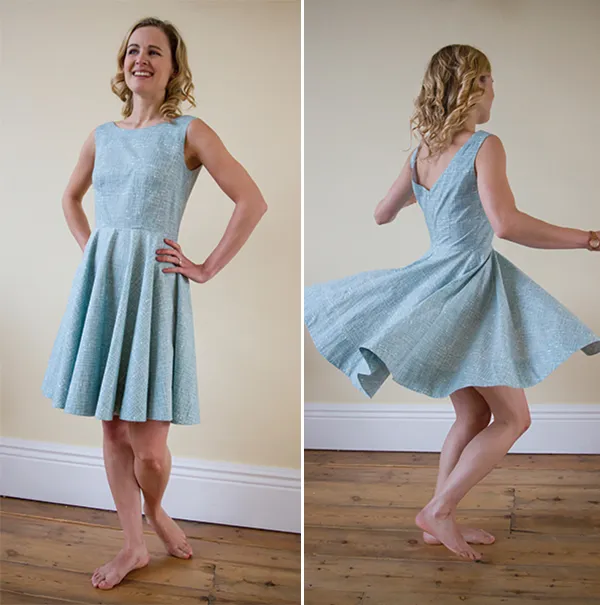We're feeling pretty groovy about sixties-style dress making after watching a vintage week episode of The Great British Sewing Bee. If you're keen to get the look, never fear - you don't have to jump straight in with PVC!
Above: Floral Full Circle Dress and Peter Pan Collar dress by Plum and Pigeon
4 reasons to sew vintage!
Lauren Guthrie of Guthrie Ghani was a Great British Sewing Bee finalist in 2013. She's kindly shared her love of old sewing patterns with us... “I love the often simple, classic styles of vintage patterns and the illustrations on the front are awesome, very inspirational – they don’t make them quite like they used to!” she exclaims. “Sometimes it’s the details like their facial expressions that make me giggle.”
History of Fashion Series
Head to our History of Fashion post to read all about the looks that shaped the key decades of the 20th Century, and find out how to sew the trends from past decades using modern patterns!

1. Connect with the sewists who came before us!
These quirky works of art only add to the charm of the vintage sewing experience, along with the tantalising idea of becoming part of a chain of keen sewists stretching back decades. Caroline Smith of Sew La Di Da Vintage says: “I enjoy the connection with the previous owner of a pattern – a pin or notes written on the envelope add to the appeal. When you open the envelope, you are dipping into their creativity.”
And then there’s the pleasure of many of these garments’ sheer femininity. “I love the timeless feminine style and the flattering shapes of the vintage designs,” says Rose Halstead at Plum and Pigeon. “I especially like the 1950s designs with fitted bodices and full circle skirts, and find there are some great vintage reproduction patterns as well as genuine vintage ones.”
Lisa Comfort of Sew Over It also loves the silhouettes of the 50s and 60s. “They were so feminine and flattering to lots of figures and shapes,” she says. “The detailing was also lovely. The only downside to using real vintage patterns is the sizing – it’s way off! Due to changes in underwear, we don’t have the same shape busts and our waists aren’t as tiny.”

Lauren Guthrie models her version of the Betty Dress by Sew Over It
2. Measure up - body shapes have changed over time!
Sad but true, we simply aren’t the same shape of former generations (apart from a few very lucky ones). This means that the biggest challenge of making a garment from a vintage pattern isn’t finding the pattern itself – it’s making all those little conversions that are required to turn it into a wardrobe essential you’ll want to wear time and again. Fortunately, there are some cunning ways to update a vintage pattern to suit current generations. “It might be something as simple as changing a neckline, which can put a modern twist on the garment,” says Lauren, “but in terms of overall style, I think it’s nice to keep things are they are.”
Sizing and proportions are the biggest hurdles to tackle, but even these are achievable, with care. “It’s best to take your own measurements and compare them against the pattern pieces themselves,” says Lauren. “If you take your waist measurement, for example, and quarter it, you can then compare this to the waist line of the pattern piece of a front/back bodice – you’ll get a feel for how much or how little ease there will be.” She also advises checking other more specific measurements, such as back length and back width, against the pattern pieces, too. “Just don’t forget to take account of the seam allowance and also remember that it’s normal for clothes to be bigger than our actual measurements so that we can actually move in them.”
Over at Sew La Di Da Vintage, Caroline’s team studied the pattern sizes, old and new. “And we realised that they were out of synch with contemporary high street sizings.” In response, they set about producing a range of patterns that they feel fit well with the modern high street offerings. “Body proportions have changed due to lots of factors: food and rationing, corsetry and underwear, hormones and the pill.” she says.

Sew La Di Da Vintage Sweetheart Dress © Matt Austin
Rose also has vital advice: “Check the finished garment measurements (these are usually displayed on the pattern pieces) before making your garment. Dress sizes have changed over the years so you might need to adjust the pattern. If you are a UK size 14, you might not be that size on the vintage pattern.” She points out that during the 1950s, women were quite petite. “Women often had an hourglass figure and small waist. Now we are slightly taller with a bigger waist and maybe a slightly bigger chest,” she says. “When working with original patterns, I have to alter the waist measurement on each size by at least an inch or two to make them modern sizes.”
Curiously, it isn’t only waists and busts that have changed over the decades. “Also look at the lengths – torsos were shorter so bodices can come up very short!” Lisa recommends. She suggests that if you aren’t too far off the pattern’s original size, “then you can usually make small adjustments,” such as redrawing side seams or making darts smaller and shorter. “Look at the bust darts,” she warns, “because these are often exaggerated.”
Lauren adds that fashions changed garment shapes even between the 1950s and 60s. “Not only have body portions changed, but the styles have changed so much in terms of how much women want to accentuate parts of their body,” she comments. “In a 1950s dress, you’re likely to find a really cinched-in waist, whereas the shift dresses of the 1960s will skim the body more.” The style of the garment and the decade it hails from also impacts the adjustments you’ll need to make, Lauren says. “It might be widening out a waistline or making a bust adjustment.” To create the perfect fit, Lisa says: “You can slash into the bodice at the relevant points, above or below the bust darts – depending on your size – and lengthen.” She adds: “I’d advise that it’s best to start with a vintage pattern that fits your bust because adjusting the waist and hips is much easier. Skirts are obviously easier to lengthen than bodices but make sure you don’t add it to the hem if it is a pencil-shaped skirt – you need to add length higher up the pattern.”
Another tip is to compare your vintage treasure with a similar pattern that already fits you. “You can redraw the darts, taking from a pattern that already fits you,” Lauren says. “Just make sure you make adjustments to the side seams if you’re making a dart bigger or smaller.” But before you get started in your chosen fabric, do take the time to make a toile, Lisa says. “There will almost definitely be some alterations, so it’s best to make it to that. That way, you will end up with a much better fitting garment.”

Sew La Di Da Vintage Rose Dress © Matt Austin
3. Give retro sewing styles a contemporary twist
Caroline has a slightly different approach, using old sewing patterns as inspiration, “for a design that looks current but with a vintage feel,” rather than working directly from old patterns. “I find that the romance of the shapes of the clothes and the style of the drawing is so evocative, and also the combinations of fabrics can be delightfully unexpected,” she says. “I try to evoke this in my patterns and examples.”
And then there’s the matter of making a vintage-inspired garment irresistible to modern dressers. “When using a vintage dress pattern, I tend to keep most of the shape of the garment the same, because this is what I love about the pattern I’ve chosen and I want the vintage style to come through in my garments,” says Rose. “I like to update the garment by using new fabrics, often ditsy floral prints and spots.” She adds: “I use a lot of cotton and cotton lawn fabrics because they come in so many lovely prints, they hang well on the garments and they are nice fabrics to sew with. It’s very important to me that each of my garments is well made using excellent quality fabric, so I usually use 100% cotton to make them long lasting.”
However, Lisa suggests paying heed to the advice on the original pattern. “I would go for the same fabric options as it recommends, unless you are confident it would work in something different.” Lauren agrees, but has an eye on practicality, too. “Choosing something that is more stable such as a light to medium-weight cotton, rather than something slinky like a viscose or rayon, will mean there’s one less thing to contend with when you have other adjustments and allowances to make.”
The fact is, the fabrics are part of the fun of a vintage-look garment. “We like to stock fabrics that hint at vintage but aren’t too obvious,” says Caroline. “We have all sorts, from basic cottons to organzas, brocades and lace.” Beyond your fabric choice, it’s all in the cunning sewing techniques you make use of, as Rose explains: “The dress patterns I use include a range of techniques including heavily gathered and pleated skirts, and sleeves that need easing into the armholes,” she says. “Almost all of the dresses I make need understitching around the neckline and armholes if they’re sleeveless – this makes it sit nicely and prevents the lining and facings from showing on the outside of the garments.”
Techniques are specific to each pattern, as Caroline notes: “Some have pleats, some have gathers, some have plain seams. Finishing techniques depend on whether there’s a lining or facing and can vary with the fabric used. Our seam allowances are 1.5cm, as in other patterns, but we allow extra in the back seam for fitting the zip – this is where you get a bespoke fit as very few people conform to a standard size.”

4. Get the swinging sixties look
If you're itching to stitch the eye-catching colour block shift dress that appeared on recent episodes of Great British Sewing Bee, we've got good news. Vogue Patterns have issued a limited edition pattern, based on the original by Yves St Laurent, inspired by artist Piet Mondrain's bold block style paintings. Make the Mondrain (Vogue pattern 1557) and is out now.
Written by Judy Darley.
